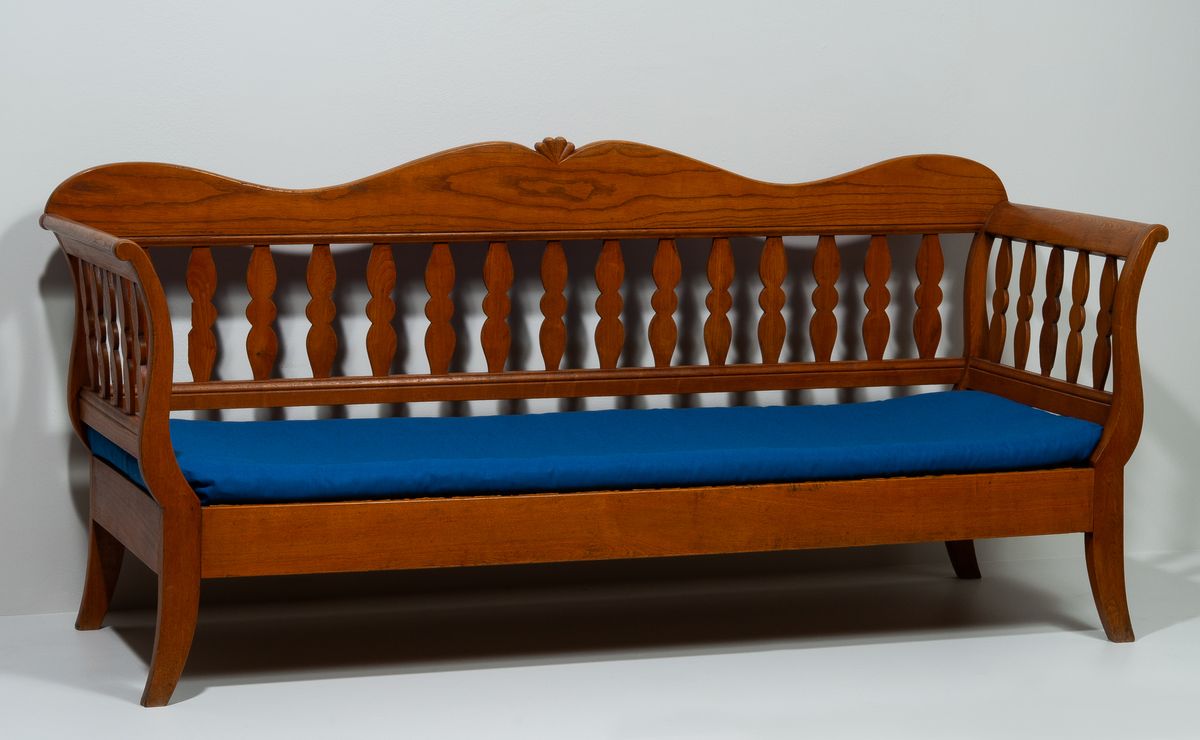
Settee
Artist:
Unknown
Date: ca. 1860-1870
Medium: Oak or ash
Dimensions:
35 3/4 x 76 1/2 x 26 in. (90.8 x 194.3 x 66 cm)
Credit Line: San Antonio Museum of Art, gift of Faith and Charles Bybee
Object number: 92.60.13
Label Text
Although this settee has a provenance from Winedale in Fayette County, Texas with a history of ownership in the Wuderlich family, its maker remains unknown. The overall form is characteristic of Texas German furniture made in the Hill Country or Brazos-Colorado regions and this settee is a particularly successful interpretation. The scrolled arms and simplified saber legs are elements which reveal the influence of late classical taste. A vernacular element is introduced into the design by the addition of flat cut double-vase-and-baluster banisters, reminiscent of architectural features seen on many country houses of the period as stair components or porch railings. Settees, which were usually cushioned by a single stuffed mattress, were much more common than fully upholstered sofas in Texas furniture. Rawhide strips were originally nailed to the inside of the frame to support the loose cushion.
(Label text, 2008 - Louisa D. Bartlett, Decorative arts consultant based in Mendenhall, Pennsylvania)
As settlers flocked to Texas during its incarnations as a republic and then a state, the need for furniture grew along with the population. The cost of importing furniture from other parts of the United States or Europe was prohibitive; thus, 19th century Texans often designed and built to suit their own needs, relying especially on the influx of craftsmen from Germany. Although the forms of Texas furniture closely resemble case and seating furniture used elsewhere, they are made of woods native to the state such as pine and walnut, and are embellished with less expensive decorations, such as simpler porcelain pulls for drawers. The objects on view were once owned by Houstonian Faith L. Bybee, a passionate collector of American furniture and decorative arts who embraced the styles of her native state as well as examples of design from the Eastern Seaboard.
(Texas Gallery, 2018)
(Label text, 2008 - Louisa D. Bartlett, Decorative arts consultant based in Mendenhall, Pennsylvania)
As settlers flocked to Texas during its incarnations as a republic and then a state, the need for furniture grew along with the population. The cost of importing furniture from other parts of the United States or Europe was prohibitive; thus, 19th century Texans often designed and built to suit their own needs, relying especially on the influx of craftsmen from Germany. Although the forms of Texas furniture closely resemble case and seating furniture used elsewhere, they are made of woods native to the state such as pine and walnut, and are embellished with less expensive decorations, such as simpler porcelain pulls for drawers. The objects on view were once owned by Houstonian Faith L. Bybee, a passionate collector of American furniture and decorative arts who embraced the styles of her native state as well as examples of design from the Eastern Seaboard.
(Texas Gallery, 2018)
Not on view
In Collection(s)
The San Antonio Museum of Art is in the process of digitizing its permanent collection. This electronic record was created from historic documentation that does not necessarily reflect SAMA's complete or current knowledge about the object. Review and updating of such records is ongoing.

 This resource has been made possible in part by the National Endowment for the Humanities: Exploring the Human Endeavor.
This resource has been made possible in part by the National Endowment for the Humanities: Exploring the Human Endeavor.
